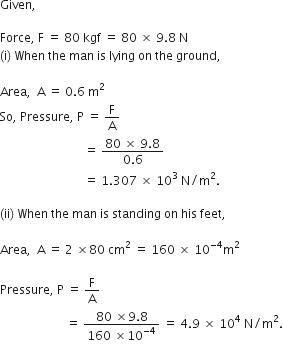How much pressure will a man of weight 80 kgf exert on the ground if (i) he is lying and (ii) he is standing on his feet? Given that the area of the body of the man is 0.6 m2 and that of a foot is 80 cm2.

How much pressure will a man of weight 80 kgf exert on the ground if (i) he is lying and (ii) he is standing on his feet? Given that the area of the body of the man is 0.6 m2 and that of a foot is 80 cm2.

Calculate the molar mass of the following substances:
(a) Ethylene
(b) Sulphur molecule, S8
(c) Phosphorus molecule, P4
(d) Hydrochloric acid, HCl
(e) Nitric acid, HNO3.
What is the mass of:
(a) 1 mole of nitrogen atoms
(b) 4 moles of aluminium atoms
(c) 10 moles of sodium sulphite.
Convert into mole
(a) 12 gm of oxygen gas
(b) 20 gm of water
(c) 22 gm of carbon dioxide.
What is the mass of?
(a) 0.2 mole oxygen atoms.
(b) 0.5 mole of water molecules.
Calculate the number of molecules of sulphur (S8) present in 16 gm of solid sulphur.
Calculate the number of aluminium ions present in 0.56 gm of aluminium oxide.
Explain law of conservation of mass.
50 g of 10% lead nitrate is mixed with 50 g of 10% sodium chloride in a closed vessel. After the reaction has taken place, it was found that 6.83 g of lead chloride was precipitated. Besides, the reaction mixture contained 90 g water and sodium nitrate. Calculate the amount of sodium nitrate formed.
Name and explain two important laws of chemical combination ?
What are the postulates of Dalton’s atomic theory of matter?
Mock Test Series